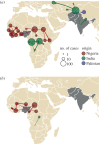The final stages of the global eradication of poliomyelitis
- PMID: 23798688
- PMCID: PMC3720038
- DOI: 10.1098/rstb.2012.0140
The final stages of the global eradication of poliomyelitis
Abstract
The global incidence of poliomyelitis has dropped by more than 99 per cent since the governments of the world committed to eradication in 1988. One of the three serotypes of wild poliovirus has been eradicated and the remaining two serotypes are limited to just a small number of endemic regions. However, the Global Polio Eradication Initiative (GPEI) has faced a number of challenges in eradicating the last 1 per cent of wild-virus transmission. The polio endgame has also been complicated by the recognition that vaccination with the oral poliovirus vaccine (OPV) must eventually cease because of the risk of outbreaks of vaccine-derived polioviruses. I describe the major challenges to wild poliovirus eradication, focusing on the poor immunogenicity of OPV in lower-income countries, the inherent limitations to the sensitivity and specificity of surveillance, the international spread of poliovirus and resulting outbreaks, and the potential significance of waning intestinal immunity induced by OPV. I then focus on the challenges to eradicating all polioviruses, the problem of vaccine-derived polioviruses and the risk of wild-type or vaccine-derived poliovirus re-emergence after the cessation of oral vaccination. I document the role of research in the GPEI's response to these challenges and ultimately the feasibility of achieving a world without poliomyelitis.
Keywords: eradication; polio; poliomyelitis; poliovirus; public health; vaccine.
Figures



References
-
- Fine PEM, Carneiro IAM. 1999. Transmissibility and persistence of oral polio vaccine viruses: implications for the global poliomyelitis eradication initiative. Am. J. Epidemiol. 150, 1001–102110.1093/oxfordjournals.aje.a009924 (doi:10.1093/oxfordjournals.aje.a009924) - DOI - DOI - PubMed
-
- World Health Organisation 1988. Global eradication of poliomyelitis by the year 2000. Forty-first World Health Assembly resolution WHA41.28. Geneva, Switzerland: WHO
-
- Sutter RW, Kew OM, Cochi SL. 2008. Poliovirus vaccine - live. In Vaccines (eds Plotkin SA, Orenstein WA.), pp. 651–705, 5th edn Philadelphia, PA: Saunders
-
- Ogra PL, Karzon DT, Righthan F, Macgilli M. 1968. Immunoglobulin response in serum and secretions after immunization with live and inactivated poliovaccine and natural infection. N. Engl. J. Med. 279, 893–90010.1056/NEJM196810242791701 (doi:10.1056/NEJM196810242791701) - DOI - DOI - PubMed
Publication types
MeSH terms
Substances
Grants and funding
LinkOut - more resources
Full Text Sources
Other Literature Sources
Medical

